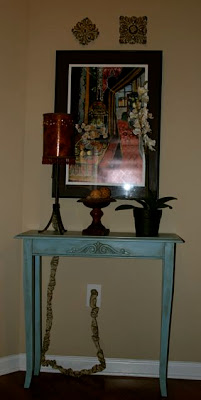(Painted) blue bayou (ha,get it?get it?).. the tutorial
After I painted this little, blue table. I received a lot of questions on how I did the glazing.. so here is the nitty-gritty tutorial… This is so easy, you’ll glaze EVERTHING!
You’ll need:
paint color of choice
paint (to glaze with) color
glaze
paper towels
brush
stir stick
I used Stratton Blue HC-142 in Benjamin Moore paint as my base color. It is a great blue with a bit of turquoise underneath. In pictures though i know it’s so hard to tell exact color.
I had this left over table floating around. So after a coat of paint (this time I used Stratton Blue, cut by 50%.) Did you know the paint store will do that.. Cut your paint? They will by 25, 50, or 75 percent. So if there is a color you love, but you think if it were just a bit lighter, there’s a great solution.
After the paint has cured a few days… You’re going to mix your paint and glaze.
The paint color I used was Tudor Brown EXT.RM (in satin finish). It’s a great chocolatey color I used in this bathroom. You can use any brown color you like, you can even use craft paint. Just buy the higher quality stuff such as Folk Art or Americana.
For my project, mix your paint and glaze in equal parts (50/50). IF you don’t want to buy the HUGE can of glaze at the paint store,the craft store sells smaller containers. If you can’t find it in the craft paint aisle, they also sell it in the fine art section.
It will look milky and the more you mix it, the better it will look.Do you like my pencil.. and my old play dough container? I go for the high tech paint equipment around here.
If you want your glaze to be more translucent, use 1 part paint to 3 parts glaze (25/75). Heavier and darker brown, 1 part glaze to 3 parts paint. I just eyeball mine. If you’re a tad bit off, it’s okay. You can always add more of either later, or do a sample board and play with your ratios.
Use a paint brush to run the glaze/paint mixture into the crevasses, then wipe off the excess right away with a dry paper towel. If you mess up, just clean it off with a damp paper towel.
With turned legs, it’s easiest to apply your glaze,
then wrap your fingers with the towel around it and twist.
Continue doing the entire piece in this manner.
The biggest trick to using glaze is DO NOT paint glaze over a fresh glazed area; you’ll lift the old glaze right up and leave funky patches.
And you end up with the perfect little, blue, glazed table.
If you feel unsure about jumping in until you get a feel for it, use a practice board.
It’s only paint. Even if you think you’ve messed up, either wipe it off or paint over it.
One of my reader’s, Anne M. was one of the first to e-mail me for my technique. She had wanted a less turqoise-y color so we ended up picking Marlboro Blue HC-153.
Here’s another paint secret I shared with Anne. Sherwin Williams will color match any color and any brand paint strip in their sampler paints. The best part is their samplers are about a full QUART and are under $6. More than enough to do a small piece of furniture or two.
Here is how Anne’s piece turned out.

Didn’t she do a great job? It’s fabulous! And I love how she accessorized the table.
And Karyn told me she’s a little glaze happy now!
I hope this helps every one! feel free to e-mail me if there was anything else you need to know!
🙂 Jen
If you are reading this post at any other sites or blogs besides Jenniferrizzo.com, your rss feed,e-mail or in your reader this is stolen content.
*This was posted Via Jennifer Rizzo. com

Just used this brilliant! technique on my first piece ever, a sideboard of all things. Tudor Brown glaze over BM Marlboro blue. Worked well with trim, but brushstrokes on broader areas looked “clunky” or too heavy-handed. Solved it by letting it dry an hour or two and then taking Mr. Clean’s Magic Sponge to it. Very happy with results. Damp Magic Sponge blended the brush marks for a wonderfully subtle effect. Enabled me to “control” where antique coloration showed up and how dark for more naturally aged look. Must be careful with overdoing it, though. Thank you for making this project so much easier than if I had to use candle wax and a cheese knife, trying to remember exactly where I had applied wax. xoxo
Wow this is perfect, I am glad I found it. I have a large (poster size) frame that I painted dark brown for a blue room and I am not happy at all with it. I am going to re-paint it light blue and glaze it. Thanks for info!
Thanks for the tutorial!! I love both tables!!